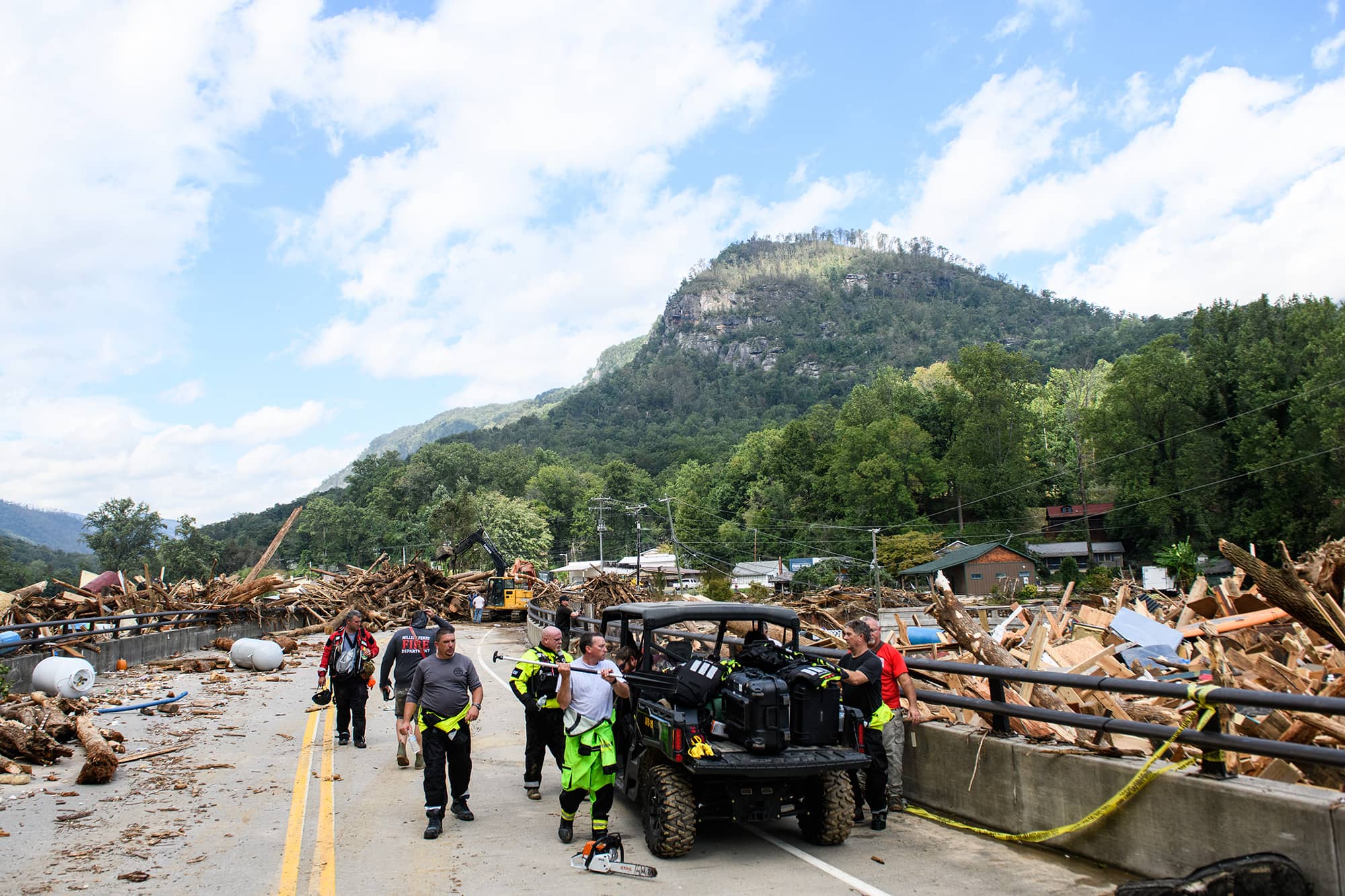Hello, and welcome back to State of Emergency. We’re Jake Bittle and Ayurella Horn-Muller, two reporters here at Grist, and we’ve been traveling up and down the Gulf Coast of Florida over the past week reporting on the aftermath of Hurricane Helene, which has devastated much of the Southeast and killed more than 100 people — likely a significant undercount.
As we’ve driven around, stopping at seven rural towns that were destroyed by the storm, we’ve run into one man over and over again: Florida Governor Ron DeSantis, who mounted a full-court press of disaster response in the days following the storm.

Helene was the strongest hurricane on record to make landfall in the Big Bend region. It devastated scores of homes in Horseshoe Beach, a rural hamlet along Florida’s northwestern coast.
Jake Bittle / Grist
Helene is by no means the first hurricane that DeSantis has had to navigate during his second and final term as governor. But the Category 4 storm is the first major hurricane DeSantis has confronted since his short-lived — and failed — bid for president. It’s also the strongest hurricane on record to ever make landfall in the Big Bend region. With just two years left in his term and another presidential run in the future likely, how DeSantis responds to Helene could make a big difference in whether he can shore up the Republican nomination for 2028.
Which may explain why, at one of the governor’s first public appearances following the storm, he dodged questions about the role of climate change in driving more frequent and intense hurricanes to the region. This approach is clearly at odds with his messaging to date on the subject. Earlier this summer, not only did he pass legislation that deletes most climate change references from state law, scrubbing emissions reduction goals from energy policy, and prohibiting local governments from limiting the use of natural gas, among other anti-mitigation measures, he has repeatedly denied that human-caused warming is making hurricanes stronger. In fact, after 2023’s Hurricane Idalia, he told Fox News that “they act like this is somehow unprecedented. And it’s not.”
“I wouldn’t hazard a guess as to why the storms have come here in the last year and a half or so.”
— Ron DeSantis, when asked about the connection between climate change and hurricanes in his state
“I wouldn’t hazard a guess as to why the storms, you know, have come here in the last year and a half or so,” said DeSantis in a press conference Saturday at Dekle Beach. “No one asked to be put in this situation. You know, I don’t have any explanation as to why we would have storms that would track into this particular part of Florida over a year and a half period. But what I do know is there’s work to do. And so we’re going to get back into the business of doing it.”
The following day, DeSantis made another appearance in the nearby town of Suwanee, where he met local officials at a Baptist church. Afterward, he helped volunteers distribute barbecue to local residents, first saying a prayer that Florida would not be hit by another storm. As DeSantis scooped out helpings of pulled pork, he threw in the occasional request for support on his efforts to defeat Amendment 4, a ballot measure that would enshrine a right to abortion. Most of those who took food greeted him warmly, saying, “Thank you for everything you do for us,” and “We love you.”
But not everyone was perfectly satisfied with the governor’s response. As DeSantis prepared to leave, a Suwanee resident named Billy Mincks approached him and pleaded with him to pay more attention to the region’s poorest residents. He had just come from mucking out his flooded house, he said, and he needed help. DeSantis responded by assuring him the state would offer assistance with home repairs.
“I like the man, I’m glad he’s our governor, but I’m tired of the little man getting looked over,” Mincks told Jake after the fact. “I hope he heard us out.”
By that time, the governor’s motorcade had already rumbled up the road toward the highway, stirring up a cloud of dust as it went.
Helene’s aftermath in North Carolina
As of Monday, flooding and mudslides triggered by Helene had killed at least 47 people in North Carolina and caused catastrophic damage that is still being tallied. Roy Cooper, the Democratic governor of North Carolina, is no stranger to storms — he’s dealt with two 500-year flood events and a 1,000-year flood in the past two years alone. At an event at The New York Times building in New York City last week, Cooper spoke about the coming storm with resigned familiarity.
“We have one coming up in the Gulf now, Helene, that I’ll go back and declare a state of emergency in North Carolina,” he said last Wednesday, a day before Helene made landfall. “We’ll get a lot of rain in our mountains, and we’ll have to deal with that.”

Approximately 6 feet of debris piled on a bridge in Lake Lure, North Carolina, in the wake of heavy rains caused by Hurricane Helene.
Melissa Sue Gerrits / Getty Images
It’s becoming clear that Hurricane Helene will go down in North Carolina history as one of the worst storms the state has ever experienced, far eclipsing anything Cooper has confronted in his seven-year tenure as governor, and one of the most expensive storms in U.S. history.
“I think people along the eastern coast of North Carolina are listening to the issues about climate change and how we need to respond to these storms,” Cooper told the Times. Whether the western portion of the state, the part hardest hit by the hurricane-fueled flooding, undergoes a similar political transformation remains to be seen.
— Zoya Teirstein
What we’re reading
Florida’s flood capital: Jake reported on the ground from Shore Acres, a low-lying neighborhood in St. Petersburg that has flooded dozens of times in the past few years. Helene delivered a historic storm surge to the neighborhood, likely tanking the real estate market there even further and forcing a sell-off of homes. 
The forgotten towns of the Big Bend: Jake and Ayurella joined a fire chief in the rural town of Inglis as she examined Helene’s damage. The small towns of the Big Bend have struggled through three storms in 13 months, and they often lack the ability to rebuild after big disasters. 
Congress pinches pennies for FEMA: The stopgap bill that Congress passed last week to avoid a government shutdown did not include a planned $10 billion infusion of cash for FEMA, reports E&E News. The agency has curbed all non-emergency programs already as its main relief fund runs low and could be out of money by the end of the year. 
The climate battleground states: Getting climate policies passed is one thing; protecting them from Republican-led opposition is another. As climate change has been dragged into the climate culture wars, a shift in the political winds can put established efforts to reduce emissions in peril. Our colleague Kate Yoder wrote about the key states where the upcoming election could make or break critical climate policies.
Reforming disaster assistance: Senators Elizabeth Warren and Ted Cruz, who are on opposite sides of the political spectrum, have teamed up on a bill that would reform how FEMA distributes disaster assistance. Perhaps most notably, it would allow communities to qualify for aid based on the cumulative damage they suffer from several small disasters. Right now, these communities often don’t receive help from FEMA in rehousing displaced people or rebuilding public infrastructure.

